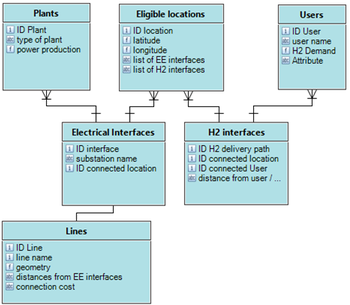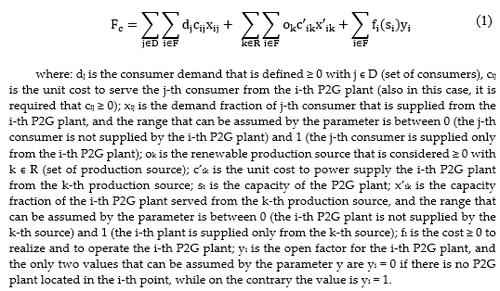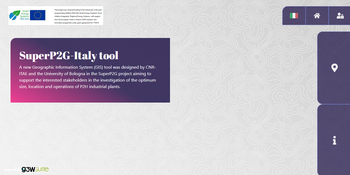THE SUPERP2G-ITALY TOOL
Introduction
The main objective of SuperP2G is to develop an open-source tool for technical/economic analysis and optimal planning of P2G plants. The tool is called SuperP2G-Italy tool and aims to facilitate sector coupling and the planning and management of the entire multi-energy system -carrier.
SuperP2G intends to show the potential of P2G in each country involved and draw pan-European conclusions regarding technology, market conditions, and stakeholder adaptation.
The tool currently developed in an alpha test version aims to minimize the total cost of operation of the energy system under investigation. Therefore, the optimization now implemented is only economic.

The database
A dedicated database has been developed for the management of georeferenced input data.
The database can handle “shapefile” or “raster” files. Once the files have been inserted, the database manages the georeferenced information through the open-source program PostgreSQL or through the Post-GIS application.
In the current version, there are two layers. All information related to mobility is stored and manipulated in a layer. On the other hand, all information pertaining to energy infrastructures is managed in the second layer. For confidentiality and security reasons, however, the information in the second layer is protected.
Design of the mesh
Being a web GIS, the tool allows the creation of a mesh of different sizes according to the required accuracy. Since there are no limits to the minimum dimensions of the mesh, reducing the dimensions means greater calculation accuracy and longer calculation times.
Given this, the potential positions of the P2G conversion plants within the territory under investigation are the nodes of the created mesh grid.
Geographical distance calculation
One of the most sophisticated functions of the tool is calculating the distance between grid nodes. To this end, two approaches are available:
- Geodetic distance, to be used in the case of connections via pipeline and electrical connections
- Real distance, i.e., considering the roads to connect the Power to the Gas (P2G) conversion plant with end users.

The objective function
The developed objective function consists of the sum of three cost contributions. Concerning the equation, the first member represents the cost of transporting hydrogen from the production plant to the final consumer. The second term, on the other hand, is the cost of transporting renewable electricity from the plants to the hydrogen conversion plant. Finally, the third term is the cost of building and operating the plant.
The optimization solving procedure
Each node represents a potential installation location for a general-purpose P2G conversion center. In the current version, the tool is supplied with a series of discrete values of possible sizes of Power to Gas (P2G) plants to contain calculation times.
Specifically to the implemented solver, many open-source and commercial tools exist for this purpose. Depending on the complexity of the objective function and constraints, the selection may be limited, for example, due to the nonlinearity of the objective function or constraint formulation. The open-source library “Pyomo” has been used due to its flexibility. This choice allowed flexible methods and options to describe the problem parameters (distances, costs, and P2G capacity values in terms of domains of existence) with specific initialization functions from pre-calculated georeferenced data

The visualization of the results
The results are displayed on the REDD interactive website (g3wsuite.it).
On the web page, it is possible to analyze various parameters of interest, such as, for example, the size, the position within the survey area, and the investment cost.
The website is constantly updated with new simulations relating to specific case studies.